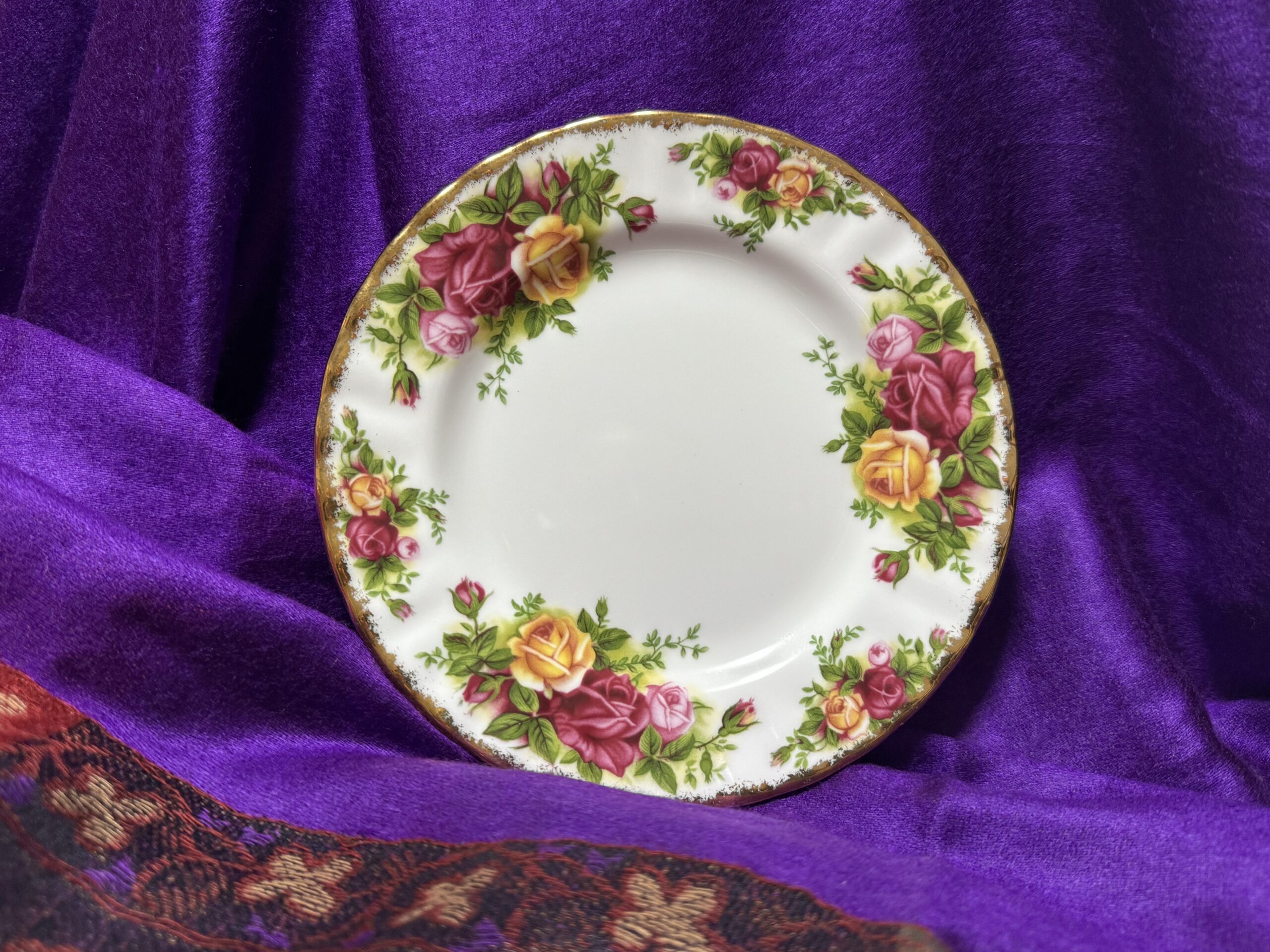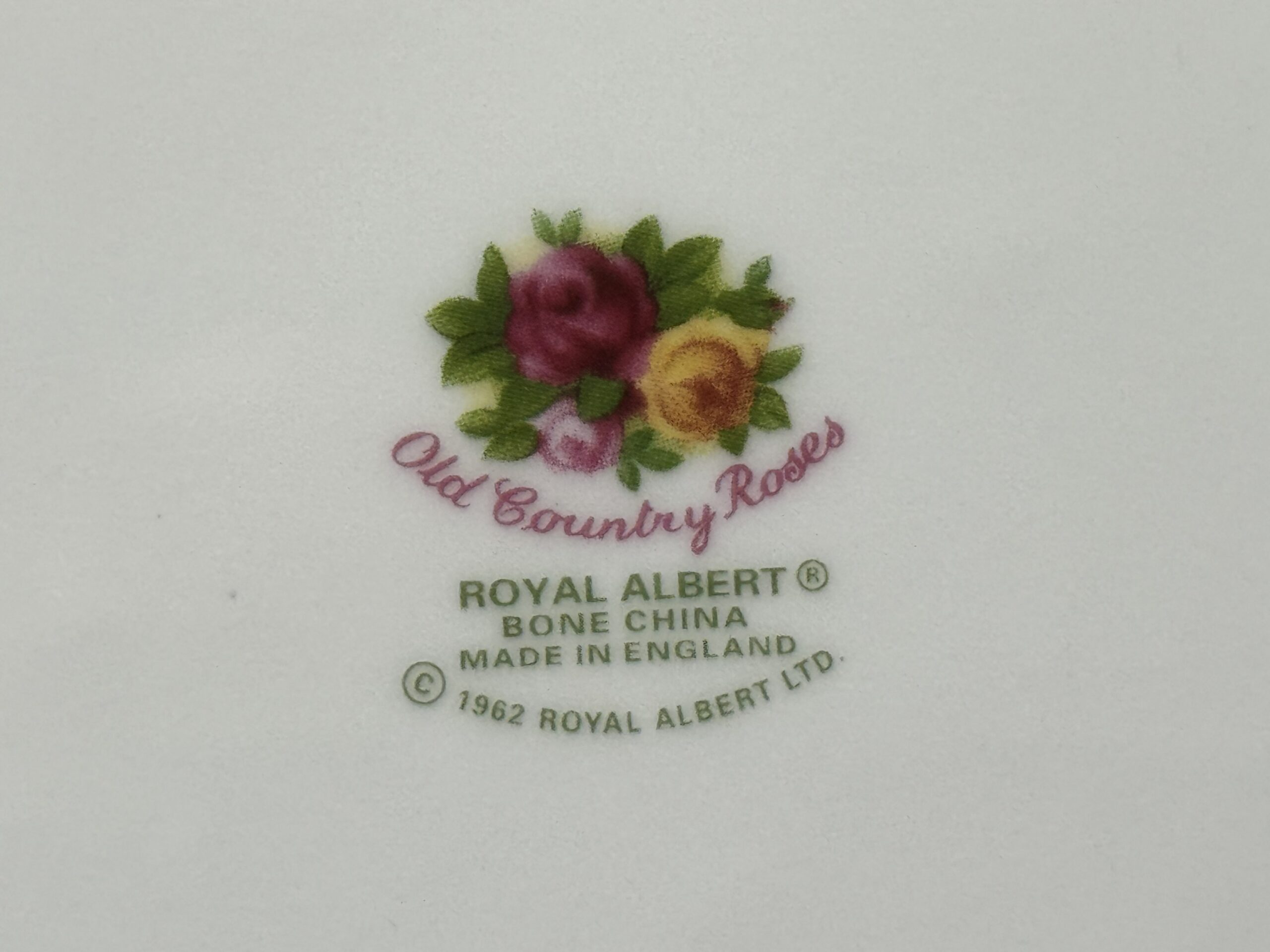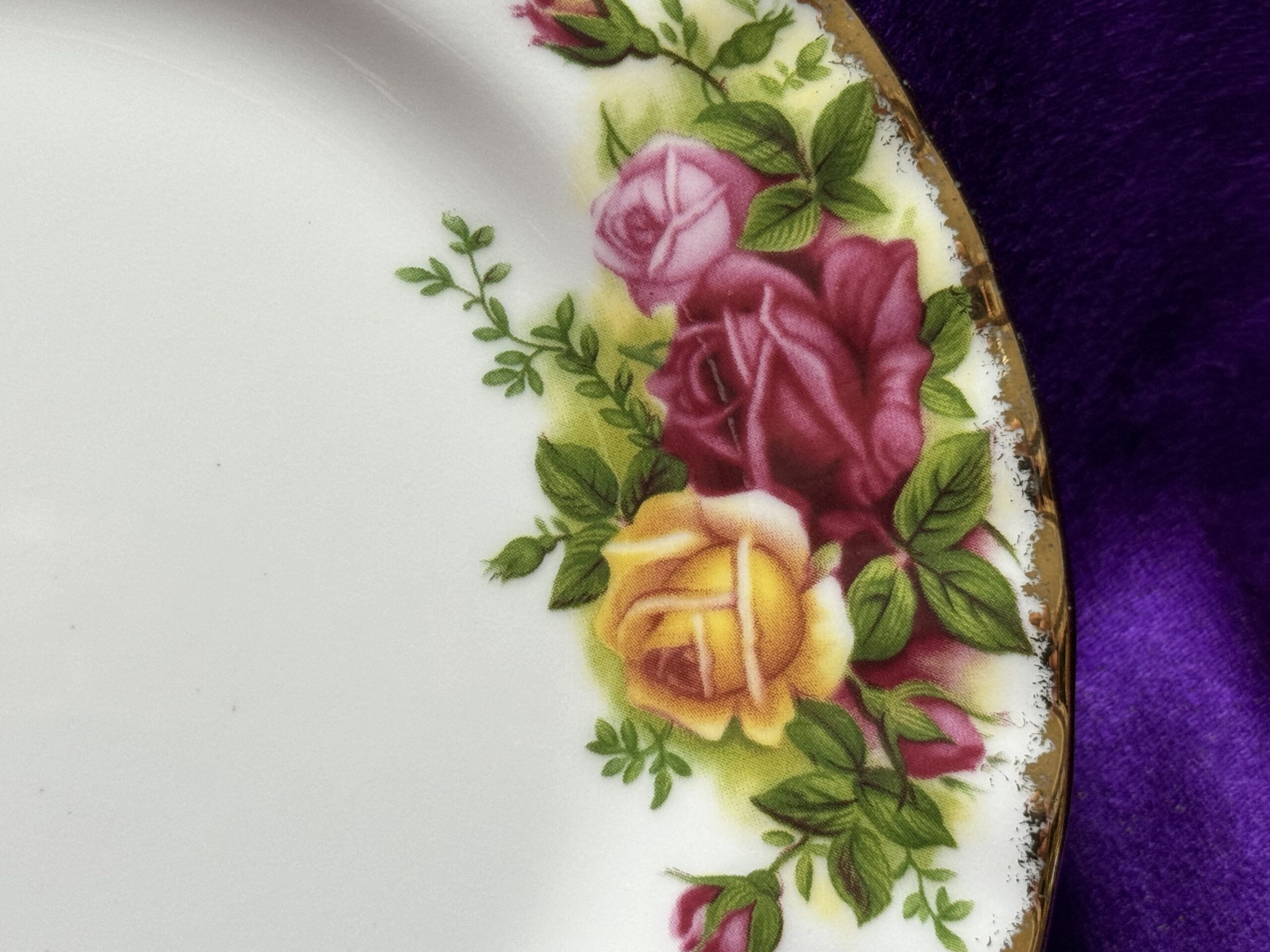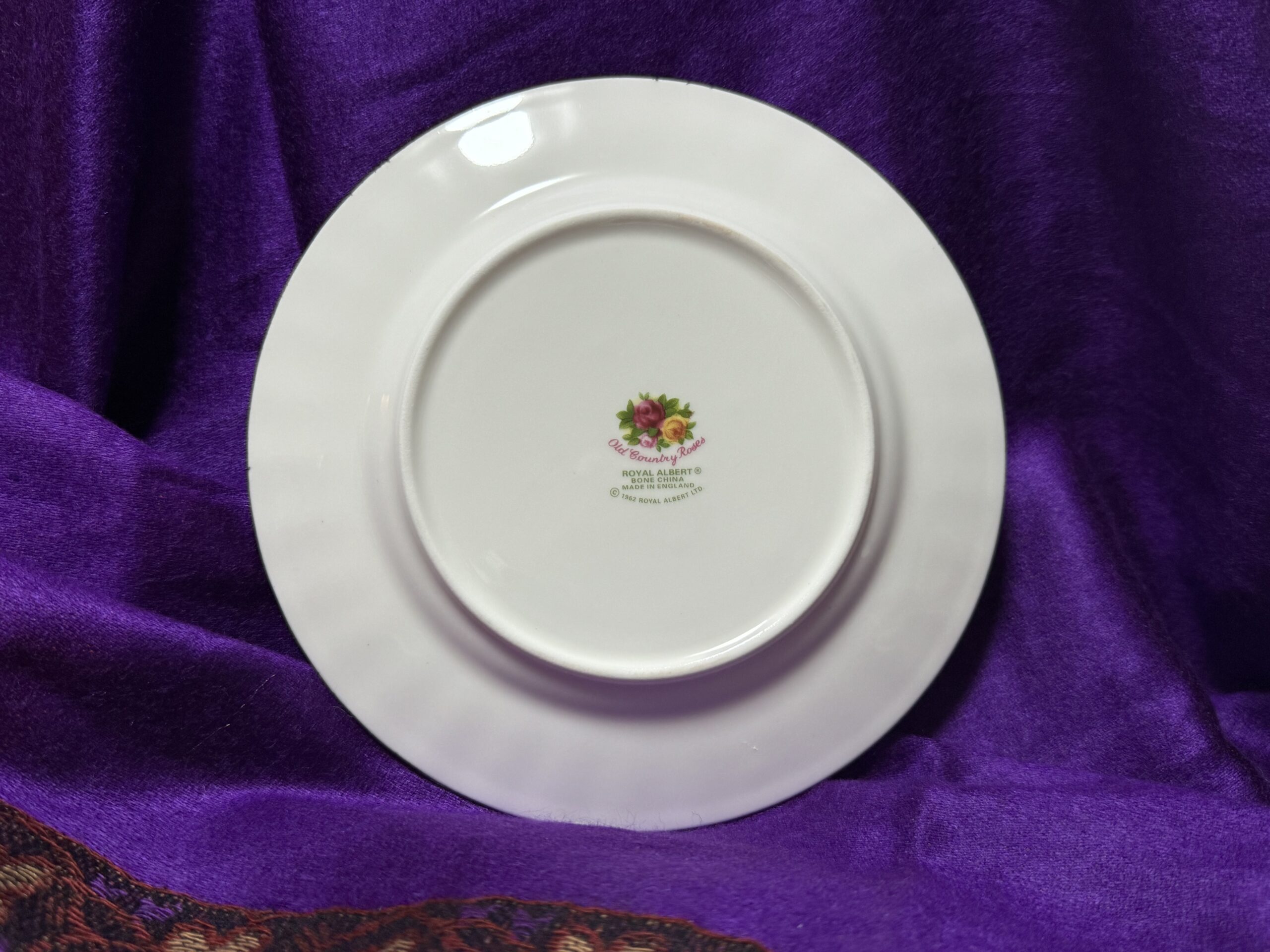XRF Test Results for Royal Albert Old Country Roses Pattern Bone China (©1962 — Made in England) Dish

For those new to the Lead Safe Mama website:
Tamara Rubin is a multiple-federal-award-winning independent advocate for childhood Lead poisoning prevention and consumer goods safety, and a documentary filmmaker. She is also a mother of Lead-poisoned children (two of her four sons were acutely Lead-poisoned in 2005).
- Tamara owns and runs Lead Safe Mama, LLC — a unique community collaborative woman-owned small business for childhood Lead poisoning prevention and consumer goods safety.
- Since 2009, Tamara has been conducting XRF testing (a scientific testing method) using the exact instrumentation employed by the U.S. Consumer Product Safety Commission to test consumer goods for toxicants (specifically heavy metals — including Lead, Cadmium, Mercury, Antimony, and Arsenic).
- Since July of 2022, the work of Lead Safe Mama, LLC has been responsible for five product recalls (FDA and CPSC).
- All test results reported on this website are science-based, accurate, and replicable.
- Items that Lead Safe Mama, LLC reports on are tested multiple times to confirm the results published (for each component tested).
- Recent notable press… There has been too much to mention already in 2024! Please check out our press page to see some of the amazing coverage of our work so far this year!
Metals highlighted below in RED are considered unsafe for humans in this application (dishware). Metals highlighted in BLUE are not considered unsafe for humans in this application (or at the levels detected in this item).
Below are the XRF test results for this Old Country Roses Royal Albert dish pictured. Note: 1962 is the design copyright for this dish, but (based on the low levels of Lead found on the food surface of this dish) it was likely manufactured at a much later date. The owner reports that this dish was purchased (new) sometime between the years 2000 and 2012.
Reading #1) Center of Food Surface on Dish
Plain White Area
60-Second Reading
- Lead (Pb): 44 +/- 10 ppm [This level is safe by all standards]
- Cadmium (Cd): non-detect
- Arsenic (As): non-detect
- Mercury (Hg): non-detect
- Iron (Fe): 1,734 +/- 152 ppm
- Copper (Cu): 86 +/- 26 ppm
- Zinc (Zn): 202 +/- 23 ppm
- Zirconium (Zr): 2,059 +/- 46 ppm
- Barium (Ba): 236 +/- 30 ppm
- Bismuth (Bi): 39 +/- 9 ppm
- No other metals were detected in Consumer Goods Mode.
Reading #2) Food Surface of Dish
Red Rose on Edge of Dish
80-Second Reading
- Lead (Pb): 74 +/- 15 ppm [This level is safe by all standards]
- Cadmium (Cd): 13 +/- 6 ppm [This level is safe by all standards]
- Arsenic (As): non-detect
- Mercury (Hg): non-detect
- Vanadium (V): 1,479 +/- 760 ppm
- Chromium (Cr): 647 +/- 341 ppm
- Iron (Fe): 1,459 +/- 165 ppm
- Cobalt (Co): 311 +/- 77 ppm
- Copper (Cu): 105 +/- 32 ppm
- Zinc (Zn): 1,607 +/- 74 ppm
- Zirconium (Zr): 3,529 +/- 88 ppm
- Niobium (Nb): 207 +/- 20 ppm
- Indium (In): 14 +/- 8 ppm
- Tin (Sn): 876 +/- 31 ppm
- Barium (Ba): 313 +/- 39 ppm
- Platinum (Pt): 69 +/- 42 ppm
- Gold (Au): 860 +/- 62 ppm
- Bismuth (Bi): 84 +/- 14 ppm
- No other metals were detected in Consumer Goods Mode.
Reading #3) Food Surface of Dish
Yellow Rose on Edge of Dish
80-Second Reading
- Lead (Pb): 69 +/- 12 ppm [This level is safe by all standards]
- Cadmium (Cd): non-detect
- Arsenic (As): non-detect
- Mercury (Hg): non-detect
- Antimony (Sb): 90 +/- 11 ppm
- Titanium (Ti): 30,400 +/- 1,400 ppm
- Vanadium (V): 1,479 +/- 760 ppm
- Chromium (Cr): 796 +/- 258 ppm
- Iron (Fe): 1,435 +/- 122 ppm
- Nickel (Ni): 580 +/- 58 ppm
- Copper (Cu): 112 +/- 24 ppm
- Zinc (Zn): 992 +/- 42 ppm
- Zirconium (Zr): 2,575 +/- 50 ppm
- Tin (Sn): 111 +/- 8 ppm
- Barium (Ba): 300 +/- 28 ppm
- Platinum (Pt): 97 +/- 32 ppm
- Gold (Au): 125 +/- 26 ppm
- Bismuth (Bi): 433 +/- 19 ppm
- No other metals were detected in Consumer Goods Mode.
Reading #4) Food Surface of Dish
Gold Border on Edge of Dish
60-Second Reading
- Lead (Pb): non-detect
- Cadmium (Cd): non-detect
- Arsenic (As): non-detect
- Mercury (Hg): 77 +/- 33 ppm [Gold is often contaminated with Mercury]
- Chromium (Cr): 601 +/- 290 ppm
- Iron (Fe): 1,355 +/- 144 ppm
- Copper (Cu): 91 +/- 28 ppm
- Zinc (Zn): 246 +/- 30 ppm
- Zirconium (Zr): 2,498 +/- 61 ppm
- Barium (Ba): 406 +/- 37 ppm
- Platinum (Pt): 72 +/ 40 ppm
- Gold (Au): 7,123 +/- 199 ppm
- Bismuth (Bi): 158 +/- 17 ppm
- No other metals were detected in Consumer Goods Mode.
Reading #5) Back of Dish
Logo
60-Second Reading
- Lead (Pb): 53 +/- 13 ppm
- Cadmium (Cd): 11 +/- 5 ppm
- Arsenic (As): non-detect
- Mercury (Hg): non-detect
- Antimony (Sb): 21 +/- 13 ppm
- Titanium (Ti): 2,545 +/- 1,351 ppm
- Chromium (Cr): 3,718 +/- 452 ppm
- Iron (Fe): 1,697 +/- 172 ppm
- Copper (Cu): 97 +/- 31 ppm
- Zinc (Zn): 465 +/- 38 ppm
- Zirconium (Zr): 2,127 +/- 54 ppm
- Tin (Sn): 119 +/- 11 ppm
- Barium (Ba): 262 +/- 35 ppm
- Platinum (Pt): 86 +/- 39 ppm
- Gold (Au): 133 +/- 33 ppm
- Bismuth (Bi): 122 +/- 15 ppm
- No other metals were detected in Consumer Goods Mode.
How much Lead is “too much” Lead?
For context, the amount of Lead considered unsafe in an item intended for use by children is anything 90 ppm Lead or higher in the paint, glaze, or coating of an item and/or anything 100 ppm Lead or higher in the substrate. Unfortunately, (as discussed in many articles here on the Lead Safe Mama website) there is no law limiting total (XRF-detectable) Lead content in dishes or cookware (or really in any consumer goods not expressly “intended for use by children”). For a detailed discussion about the concern for Leaded glaze on new or vintage dishware, click here.
The levels of both Lead and Cadmium found on this dish are considered safe by all standards. The fact that traces of Mercury were found in the Gold edging is not unexpected (giving the edging is made of real Gold and Gold is often contaminated with Mercury — you can read more about that here). There is no regulatory limit for Antimony in dishware. Antimony is similarly toxic to Lead and was added to the list of known carcinogens (for incidental exposure to consumers, vs. industrial exposure/ occupational exposure) in December of 2021.
Some additional reading that may be of interest:
- More Royal Albert dishes we have tested & reported on
- Can I test my own dishes myself at home?
- What can I test with a home test kit?
- Can I send you a dish to test?
- How to use this website to search for products you have in your home (a video)
- Safer (Lead-free) choices for dishes and other items in your home
As always, thank you for reading and sharing articles from LeadSafeMama.com. Please let me know if you have any questions and I will do my best to answer them personally as soon as I have a moment.
Tamara Rubin
Owner — Lead Safe Mama, LLC
#LeadSafeMama
Never Miss an Important Article Again!
Join our Email List












Sorry to ask this but reading all of this would you consider it safe even with the gold edges?
I’m confused why the country roses design would be safe, but other plates seem to be skyrocketing in lead. I’m trying to figure out about Lavender Rose – if anyone knows?
Likely because different colours have different levels of metals in them. That would be my guess?
Ok. I’m confused . So are
They safe or not?
Could you check level in Lorraine royal Albert